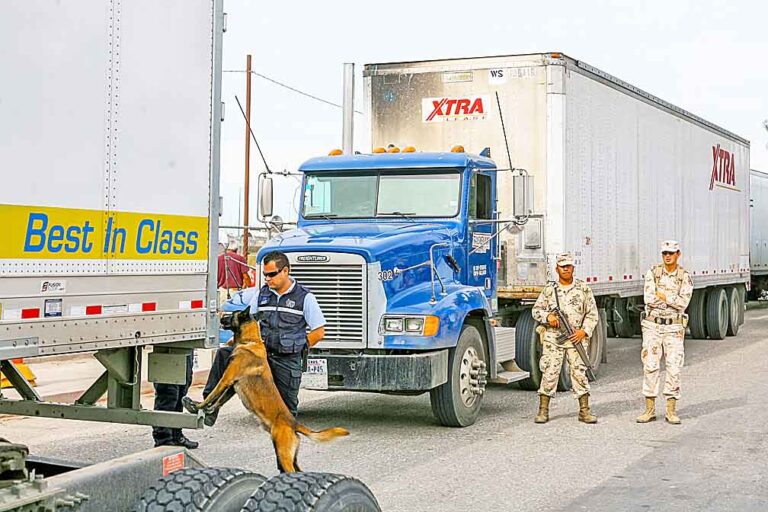WASHINGTON – The Biden Administration and the U.S. General Services Administration (GSA) have announced major land port modernization and construction projects funded through the Bipartisan Infrastructure Law signed into law last year. The law includes $3.4 billion for GSA to build and modernize land ports of entry on the country’s northern and southern borders.
The investments are designed to improve commerce and trade, create good-paying construction jobs and incorporate new and innovative sustainability features.
“America’s land ports are vital to our economy and our security, with billions of dollars in goods and services crossing our borders each and every day,” said GSA Administrator Robin Carnahan. “These bipartisan investments are a historic opportunity to modernize our land ports in ways that will create good-paying jobs and strengthen supply chains, while enhancing safety and security.”
“Our underfunded and outdated infrastructure has real costs to families, our economy, and our global competitiveness,” said Senior Advisor & White House Infrastructure Coordinator Mitch Landrieu. “President Biden’s Bipartisan Infrastructure Law is investing in strengthening our supply chains, including our land ports which are vital for moving goods across our borders.”
Billions of dollars in goods and services pass through U.S. land ports each and every day. But commercial capacity at many land ports is limited by outdated infrastructure, resulting in long lines and wait times for commercial traffic. Most of the 26 major modernization projects that will be funded through the law have elements that will enhance commercial processing capabilities.
These projects will also support U.S. Customs and Border Protection’s mission to safeguard America’s borders. For example, many of these modernization projects will allow CBP to more effectively deploy the latest technology to identify high risk activity and shipments, combat drug trafficking, and increase operational security.
“This is a once-in-a-generation investment that will enhance CBP’s mission to facilitate lawful trade and travel while protecting the American people and strengthen our borders,” said CBP Commissioner Chris Magnus. “CBP’s ability to identify, screen, and inspect high-risk persons or cargo depends greatly on the operational utility of its land port of entry inspection facilities. This investment will improve our operational capabilities and facility infrastructure, as well as help mitigate the negative economic impact of border wait times, facilitate the economic development and growth in the border communities, and benefit the American economy on the border and beyond.”
The $3.4 billion in direct spending by GSA is estimated to support, on average, nearly 6,000 annual jobs over the next 8 years; add $3.23 billion in total labor income across the United States; contribute an additional $4.5 billion to the National Gross Domestic Product; and generate hundreds of millions of dollars in tax revenue for state, local, and federal governments.
“The land ports of entry create important investment opportunities in local communities. We are excited to work with local communities to maximize the quality of connections, achieve sustainability goals, and create local jobs and business opportunities,” said Public Building Services Commissioner Nina Albert.
Examples of port modernization projects that will move forward under the plan include (estimates subject to change):
- More than $200 million* for a new commercial port in Douglas, AZ. to better facilitate the crossing of commercial goods, produce, and equipment as well as to act as a regional economic engine.
- More than $100 million to complete the final phase of the Calexico West LPOE modernization and expansion project, reducing border wait times and enhancing U.S. Customs and Border Protection’s ability to conduct its mission.
- More than $115 million to complete the modernization of the San Luis I Land Port of Entry (LPOE) in San Luis, AZ., an important port for the U.S. food industry and related supply chains.
- Nearly $150 million for an expansion of the existing port in Highgate Springs, VT. to accommodate greater movement of commercial goods and services between the U.S. and Canada.
- More than $20 million to increase the number of inspection lanes at the Pacific Highway Land Port of Entry in Blaine, WA. to significantly reduce wait times for both commercial and non-commercial traffic.
- Approximately $250 million to complete a major land port modernization project at International Falls, MN, the highest traffic volume port in Minnesota, to expand processing and inspection capacity.
- More than $187 million to modernize the Alcan, AK. land port of entry, originally constructed in 1972, to enhance security and facilitate trade, and ensure a safe living environment for CBP staff operating in the remote location.
*Note: Estimated project costs are planning estimates and subject to change due to time and market conditions.
For more information on GSA’s Land Ports of Entry, click here.
The major projects moving forward under the law are:
- Alcan, Alaska
- San Luis, Arizona
- Douglas, Arizona
- Raul Hector Castro, Arizona
- Calexico, California
- Porthill, Idaho
- Coburn Gore, Maine
- Calais-Ferry Point, Maine
- Fort Fairfield, Maine
- Limestone, Maine
- Houlton, Maine
- International Falls, Minnesota
- Grand Portage, Minnesota
- Dunseith, North Dakota
- Rouses Point, New York
- Trout River, New York
- Bridge of the Americas, Texas
- Brownsville-Gateway, Texas
- Highgate Springs, Vermont
- Alburg Springs, Vermont
- Beebe Plain, Vermont
- Norton, Vermont
- Richford – Route 139, Vermont
- Sumas, Washington
- Lynden, Washington
- Pac Highway Lane Expansion, Blaine, Washington
The Trucker News Staff produces engaging content for not only TheTrucker.com, but also The Trucker Newspaper, which has been serving the trucking industry for more than 30 years. With a focus on drivers, the Trucker News Staff aims to provide relevant, objective content pertaining to the trucking segment of the transportation industry. The Trucker News Staff is based in Little Rock, Arkansas.















